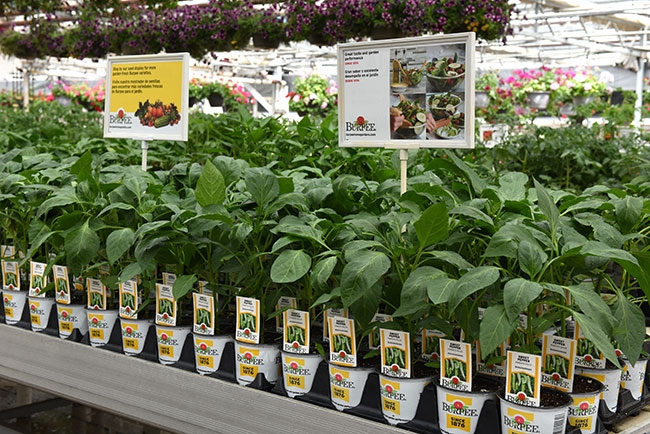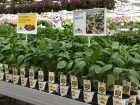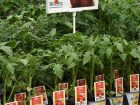
Features
Business
Retail
How to engage newer, younger vegetable gardeners
To engage with newer vegetable gardeners, we need to understand what different consumers need. It’s about helping them make choices that suit their lifestyle.
August 20, 2018 By Tim Duffin
 Plant tags should tell consumers what they’re buying - take this “sweet pepper” for instance. Show a picture of what the fruit looks like at harvest. Photo credit: Burpee
Plant tags should tell consumers what they’re buying - take this “sweet pepper” for instance. Show a picture of what the fruit looks like at harvest. Photo credit: BurpeeThe profile of today’s gardener is getting younger – 18 to 34-year-olds now occupy 29 per cent of all gardening households, according to the “2018 National Gardening Survey” from U.S-based GardenResearch.com.
This percentage was noted as an all-time high in millennial garden participation. But the stats translate to Canada as well: more millennials are gardening, and they’re growing in urban, smaller-space areas. Balconies (33 per cent) and indoors (23 per cent) were frequently reported garden locations, according to a Statistics Canada survey in 2015.
Other emerging segments include raised-bed gardening, containers, as well as houseplants and kitchen herb gardens. But while eagerness to grow vegetables seems steady and rising, there are still obstacles to retaining these new gardeners.
To engage with newer vegetable gardeners, we started by understanding what the consumer needs to be a successful gardener.
First, we conducted some observational research. Sounds fancy, but what we did was go into retail garden centres and we watched consumers. (Alright, that’s kind of creepy.) We watched, and we talked to consumers about the process they went through while they shopped for vegetables and herbs. We found out quite a bit, actually.
If our plants were going to become their brand of choice, there were some pain points that we were going to have to address. First and foremost they told us that they’re confused; there’s just too much going on in the garden center as it relates to vegetables and herbs. Why are there so many tomatoes? Isn’t a “tomato” just a tomato? And what happens when I buy this green plant – how do I know what it’s going to grow up to be? Will I know for sure that it will live where I live?
But most importantly, what happens when it does live and I have to harvest the fruit from it? What do I do with the produce? These are the concerns of the consumers that we’re dealing with. These are their pain points. Now this is how we answer their questions.
First, we try to build up the confidence of consumers. We start by sharing with them some basic facts about the brand. It’s been around for 142 years – that gives us some street credibility. In addition, we offer varieties that have both garden performance and great taste, because that will help them become successful gardeners.
All good, but not enough. So, we looked at the way consumers live their lives, and how those lives impact their motivations for gardening – especially the new or younger gardener. We took all of the varieties in our program and we broke them into smaller collections to make it easier for consumers to choose the plants that work for the way that they live and grow food.
For example, if you live in a smaller space – a condominium, an apartment, a smaller house – you don’t have a big yard in which to garden. We created a ‘space saving’ collection that is container vegetables and herbs – things you can grow on your patio, deck or rooftop – and meets those gardeners’ needs.
We have a ‘foodie’ collection for folks who like to watch cooking shows and want to partake in the joy of creating culinary masterpieces. It’s all about entertaining, and the experience of growing and preparing food and recipes.
And then there is another group of gardeners who want to grow the largest pepper, the first tomato, the latest-flowering basil. That collection reaches the gardener who enjoys the show-off part of the growing experience. Additional collections, like ‘organic’ and ‘indoor herbs’, also tie into certain gardener demographics. In short, we’ve taken this big collection of 200+ varieties and we broke them into smaller pieces for the consumer.
We’ve also wrapped it in a nice package so that when they get to the garden center, they know exactly where to go for this brand. We’ve created a pot that we believe will really attract their attention across the store, and we’ve designed an informational tag that gives them what they need.
Our new plant tags don’t start by listing the variety name. If you were to see “Confetti” in a store, you wouldn’t know what you were buying. But if the first piece of information was “Sweet Pepper,” now you know what you’re buying. Then we show you a picture of what the fruit looks like at harvest, list how many days it takes to mature, and how large the plant will be. All this makes it easier for the consumer, addressing their pain points.
Today’s gardener is very interested in knowledge. They have easy access to instant answers from their phones, apps, home speaker systems and more. Information is key to success.
As a retailer, using special point-of-purchase (POP) posters, banners and bench signs helps make shoppers the best and most successful gardener, which means repeat business year after year. The signage and tags also bounce shoppers to websites where we have blogs, videos, podcasts and tools for season-long support.
The growing household spend in the lawn and garden segment, plus the rising ratio of a new and younger gardener, makes this an excellent time to explore more ways to engage your customers. It’s about helping them make their lives easier with relevant choices in vegetables and herbs.
Tim Duffin is program director of the Burpee plant brand offered through Ball Seed. For details on how to become a certified Burpee grower, visit www.burpeehomegardensbrand.com.
Print this page

